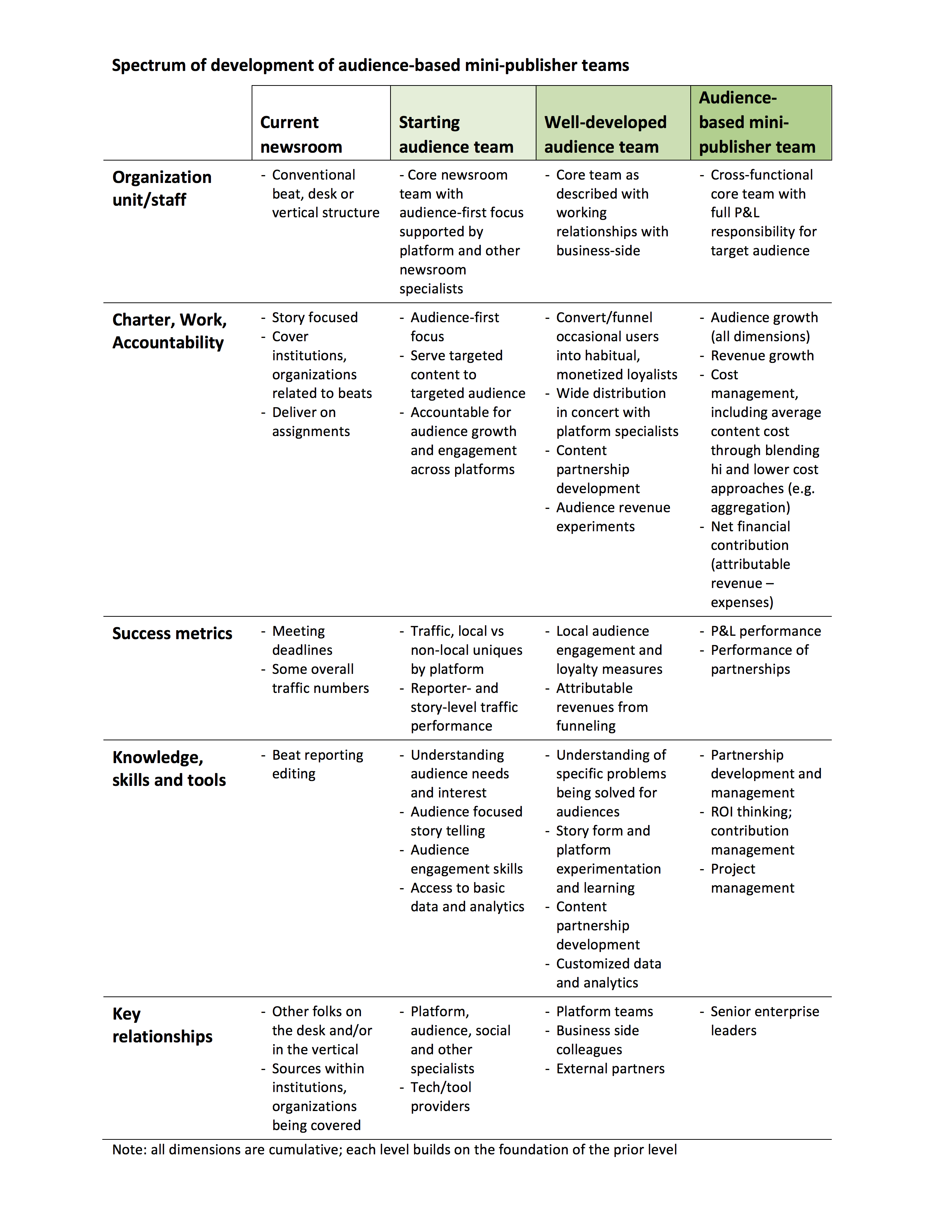Organize your newsroom around audience-driven teams
Douglas K. Smith, Quentin Hope, Tim Griggs, Knight-Lenfest Newsroom Initiative,This is an excerpt from “Table Stakes: A Manual for Getting in the Game of News,” published Nov. 14, 2017. Read more excerpts here.
You must get going now, first, to foster an audience-first approach across your newsroom – then select some teams to begin learning-by-doing how to shape and deliver targeted content to targeted audiences.
Eventually, you should organize the whole newsroom around audience-driven teams and, as Table Stake #7 describes, have mini-publishers drive those efforts. The following picture from Table Stake #7 describes stages through which newsroom leaders can guide the transition from current approaches to mini-publishers – in effect, a picture or vision for where you’re headed.

Table Stake #7 also lays out the progression toward having mini-publishers drive your platform efforts too. And, of course, all seven Table Stakes – and the step-by-step guidance contained in this manual – will help you make the full transition.
For now, though, your senior newsroom leaders need to move as quickly as possible toward the second and third stages described in the above table. As you do, keep your eye on driving toward more and more teams serving targeted “content plus” approaches to target audiences. In particular, senior leaders must hold themselves accountable to:
| Assign staff and provide resources | – Assign staff for the target audience teams
– Assign additional staff as shared resources to the audience teams (e.g. specialists in social media, audience engagement, coders/developers, video/photo and so forth) – Make sure to set explicit expectations for how much effort is required from these shared resource folks – Assist in developing any external partnerships that will help audience teams succeed |
| Set objectives and review performance | – Set and pace audience development goals and objectives, including weekly, biweekly, monthly, quarterly targets (whatever combination makes most sense)
– Conduct regular review sessions to assess performance, raise and resolve issues, and identify next steps |
| Providing ongoing support and coordination with the rest of the newsroom | – Advise, coach and support audience team leaders regarding audience growth strategies/tactics, continued development of the team’s content strategy, and team member skills development
– Make sure teams have support for the audience data, analytics and reports they need – Ensure needed social media and other audience development support – Resolve any issues among audience teams as well as among audience and platform efforts that they cannot resolve themselves |
There are multiple pathways for moving your newsroom through the stages described earlier. In a sense, though, all these choices sit between two basic approaches:
| Transform the existing newsroom organically and in team based increments | | Transform the existing newsroom with a complete and thorough reorganization |
|---|---|---|
| Identify and launch a small number of audience teams. Then expand on their efforts organically and incrementally across the entire newsroom. | Switch to a new audience-driven, digital-first newsroom organization structure in one big move – then develop audience-focused teams within the new structure. | |
| Case example:
Within its existing structure, the Miami Herald experimented with one audience team and then moved to four more. These teams helped foster audience focused thinking and analysis in ways that led to reallocating staffing across desks, shifting more staff to The Herald’s Central News Desk, and making additional staff cuts from an audience perspective. None of this was done according to a predefined master plan. Yet, the results after a year was still a major transformation of the newsroom organization. |
Case example:
Based on a through newsroom-wide organizational review, deep analysis of audience data, and sweeping recommendations, the Dallas Morning News restructured its entire newsroom around new digital content verticals and more audience-focused “hubs” within the verticals, along with an entirely separate print publication team. This redesign included many newly defined positions and extensive revisions of others. Over an intense three-month period everyone in the newsroom had to reapply for jobs as part of putting the new structure in place. Once that was done, Dallas then focused on implementing the new structure – making it work as intended – through such steps as skills training, implementing of a new CSM, instituting redesigned workflows (e.g. their morning ‘headline rodeo’), and asking reporters to develop and pitch “obsessions” to instill an audience focus (see the earlier sidebar on obsessions in Section 6d3). |